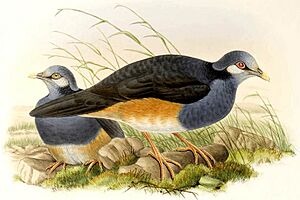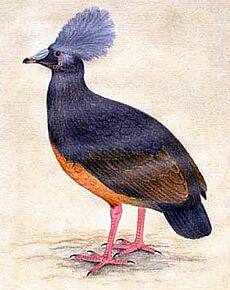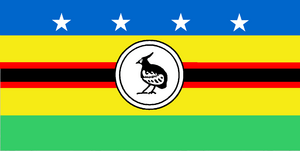Choiseul pigeon facts for kids
Quick facts for kids Choiseul pigeon |
|
|---|---|
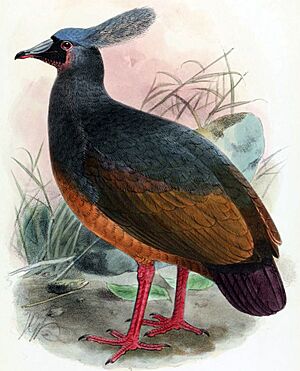 |
|
| Illustration by J. G. Keulemans, 1904 | |
| Conservation status | |
| Scientific classification | |
| Genus: |
Microgoura
|
| Species: |
meeki
|
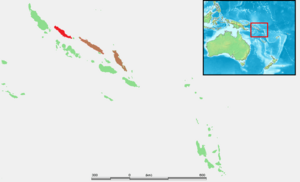 |
|
| Red denotes Choiseul, the species' confirmed range, while brown denotes Santa Isabel and Malaita, which had unconfirmed reports. | |
The Choiseul pigeon (Microgoura meeki) was an extinct bird that belonged to the pigeon and dove family, Columbidae. This special bird lived only on Choiseul Island in the Solomon Islands. There were some stories that it might have lived on other nearby islands too, but these were never proven. The last time anyone officially saw a Choiseul pigeon was in 1904. People also called it the Solomons crested pigeon or Kuvojo.
The Choiseul pigeon was the only species in its group, called Microgoura. It had no known types or subspecies. Scientists believe its closest living relative is the thick-billed ground pigeon. The adult Choiseul pigeon was mostly blue-grey with a buffy orange belly. It had a unique slaty-blue crest on its head. No one knows exactly how this crest looked when the bird was alive. The pigeon's head also had a blue patch near its beak and a two-colored beak. Its wings were brown, and its short tail was a dark purplish-black. People said it had a beautiful, rising and falling whistling call.
Since the bird became extinct before many studies could be done, we don't know much about its daily life. It probably lived on the ground and laid only one egg in a simple nest on the ground. It rested in pairs or small groups in low bushes. People said it was very calm and easy to catch. The Choiseul pigeon lived in lowland forests, especially in swampy coastal areas without mangroves. Only one person, Albert Stewart Meek, ever recorded finding them. He collected six adult birds and an egg in 1904. Even though many people searched later, the bird was never seen again. It was likely already rare when Meek found his specimens. Local people believed the pigeon disappeared because of cats brought to the island. The pigeon had never faced a meat-eating mammal before. The last unconfirmed report of a Choiseul pigeon was in the early 1940s.
Contents
Discovering the Choiseul Pigeon
The Choiseul pigeon was first described by Walter Rothschild in 1904. He based his description on six bird skins (three male and three female) and one egg. These were collected by Albert Stewart Meek earlier that year. The pigeon was placed in its own unique group, Microgoura. This name comes from ancient Greek words meaning "small" and "goura," which is a local name for the similar crowned pigeons. Rothschild named the species meeki after Meek, the collector.
Scientists think the Choiseul pigeon was most closely related to the thick-billed ground pigeon (Trugon terrestris). This bird lives in Indonesia and Papua New Guinea and has similar feathers. Some have suggested the Choiseul pigeon might connect the thick-billed ground pigeon to the crowned pigeons. However, others disagree because its crest was quite different.
Today, five skins and part of a skeleton are kept at the American Museum of Natural History. One skin and the egg are at the Natural History Museum at Tring in England. The Choiseul pigeon was known by many names, including Solomon crowned pigeon and Meek's ground pigeon. The local people of Choiseul called it "kumku-peka" or "kukuru-ni-lua," which means "pigeon-belong-ground."
What the Choiseul Pigeon Looked Like
The Choiseul pigeon was about 31 cm (12 in) long. Its wings were about 195–197 mm (7.7–7.8 in) for males and 180–190 mm (7.1–7.5 in) for females. Both male and female adult Choiseul pigeons were blue-grey with a buffy orange belly.
The bird had a very noticeable, long, rounded crest that felt a bit like hair. This crest, like the top of its head, was slaty-blue and grew from the back of its head. We don't know exactly how the pigeon held its crest when it was alive, because Meek's notes didn't say. Artists have drawn it in different ways. Some show it flat, while others show it spread out like the crowned pigeons. It's possible the crests on the museum specimens flattened during preparation.
On the pigeon's forehead was a bare, pale blue patch. This was surrounded by short, black feathers that went from the beak to just below the eye. The area below the eye was a light pink. Its chin and throat had a few black, velvety feathers. The neck was slaty-blue, turning into a brownish-grey chest. The belly and feathers under the tail were a rich orange. The tail was short, rounded, and a very dark indigo with a slight purple shine.
The beak had two colors: the upper part was chalky-blue with a black tip, and the lower part was red. We don't know what young pigeons looked like. The bird's feet were a dull purplish-red and had no feathers up to the heel. Its eyes were dark brown.
The pigeon's voice was never recorded by scientists. However, after it became extinct, local people described it as having a "beautiful rising and falling whistling call." They said it made this call from its resting spot every evening. Others described the call as a low "c-r-r-ooo" or "cr-o-o-o."
How the Choiseul Pigeon Lived
We don't know much about the Choiseul pigeon's behavior because it disappeared before scientists could study it properly. It was probably a ground-dwelling bird, meaning it spent most of its time on the forest floor. It likely found its food and built its nest there.
Local people from the town of Vundutura said the pigeon would rest in pairs or small groups of three or four in small bushes close to the ground. They claimed the bird was very calm and allowed hunters to pick it up by hand. They also reported that the pigeon had small stones in its gizzard, which birds use to help digest food. It laid a single dark, cream-colored egg in a simple dip in the ground. The egg was about 43 by 31.3 mm (1.69 by 1.23 in) in size, which is quite small for the size of the bird.
Where the Choiseul Pigeon Lived
The Choiseul pigeon did not migrate. It is thought to have lived on the forest floor in lowland forests. This included swampy coastal areas that did not have mangroves. The Choiseul pigeon is usually believed to have lived only on Choiseul Island in the Solomon Islands. This is where the only specimens were collected. The birds Meek found were probably near Choiseul Bay in the northern part of the island. The last reports from local people came from the Kolombangara River area.
There were also stories that the pigeon lived on the nearby islands of Santa Isabel and Malaita. Some even thought it might have lived on Bougainville Island. However, these stories were never proven. It would be very unusual if the Choiseul pigeon lived only on Choiseul Island, as no other bird species lives only there.
Last Known Sightings
In January 1904, six specimens and an egg were collected by Albert Stewart Meek. He was a bird collector working for Lord Walter Rothschild. He found them near Choiseul Bay on Choiseul Island. Some local boys told Meek that the pigeon was also on Santa Isabel and Malaita. Meek searched for the pigeon on Bougainville Island but found no signs of it. No other specimens were ever collected or seen by Western scientists.
Scientists did not search for the Choiseul pigeon again until 1927 and then in October 1929. During the 1929 search, five experienced collectors spent three months looking for the pigeon in many places across Choiseul. They did not find any. The local people interviewed during this trip mostly believed the pigeon was already extinct in 1929. The last unconfirmed sighting by a local person was in the early 1940s near Sasamungga by the Kolombangara River.
In the 1960s, British bird expert Shane A. Parker searched for the pigeon on small, cat-free islands like Rob Roy Island and Wagina, and in Choiseul's swampy coastal areas. He found no signs of the bird. American scientist Jared Diamond also searched in 1974 without success.
The Choiseul Pigeon and People
This pigeon was a source of food for the local people. They would find its resting spots by listening for its calls or by looking for droppings below its perches. The local people remembered the bird well. Stories about the delicious ground-dwelling pigeon were passed down by elders even after it became extinct. One local person hinted that the pigeon's gizzard stones might have been valuable.
After its discovery, many Western bird collections wanted its skins. The Whitney South Seas Expedition spent three months and a lot of money on Choiseul, mainly to find the Choiseul pigeon. In 2012, the Choiseul pigeon was featured on a stamp from Mozambique along with other extinct birds. The Choiseul pigeon is also shown on the flag of the Choiseul Province.
Why the Choiseul Pigeon Disappeared
The local people believed the pigeon became extinct because of feral cats and, to a lesser extent, feral dogs. Choiseul Island did not have any native meat-eating mammals. This made the ground-dwelling pigeon very vulnerable to the cats that were brought to the island. If the pigeon had lived on islands where feral cats never arrived, it is thought that clearing its forest home would have caused its local extinction.
Since there have been no confirmed reports of the bird since 1904, despite many searches, the IUCN (International Union for Conservation of Nature) has declared it extinct. Several bird experts had visited Choiseul and nearby islands before Meek without seeing any sign of the bird. This suggests that the Choiseul pigeon was likely already close to extinction in 1904.



